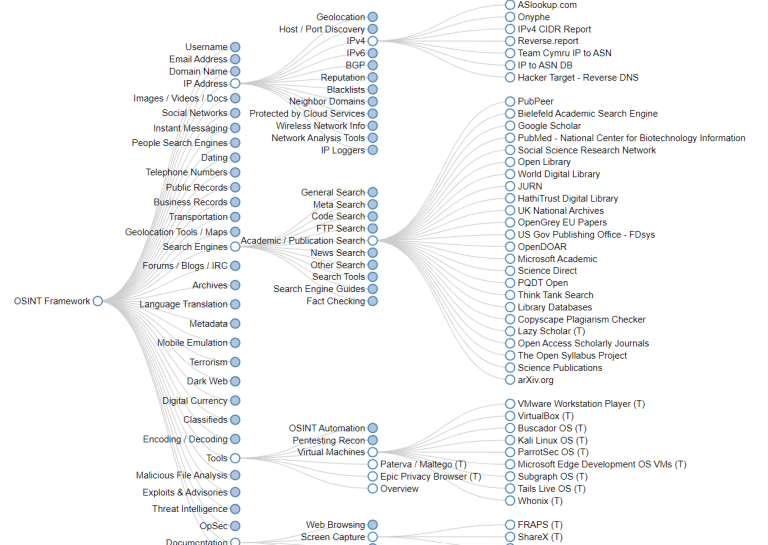Introduction:
An OSINT framework is a collection of methods, resources, and technologies for gathering, processing, and presenting open-source information (OSINT). The practice of acquiring information from publicly accessible online sources is streamlined and improved through OSINT frameworks. These frameworks offer an organized method for extracting, correlating, and analyzing data from diverse sources, enabling researchers, analysts, and investigators to find insightful information. OSINT frameworks are often made up of software programs, libraries, APIs, scripts, and procedures that are meant to aid in the OSINT workflow. They include features like data aggregation, enrichment, visualization, and correlation to aid in successful analysis and decision-making. These frameworks frequently interact with a variety of data sources, such as social media platforms, search engines, public databases, and specialized OSINT tools. Users may utilize OSINT frameworks to automate repetitive activities, effectively analyze massive amounts of data, and find connections and patterns that may not be obvious. These frameworks improve the efficacy and efficiency of OSINT investigations by allowing experts to collect and analyse data more thoroughly. OSINT frameworks can be customized and extended to suit specific requirements, with developers often creating plugins or modules to enhance functionality and support integration with additional tools or data sources. The availability of a wide range of OSINT frameworks enables professionals to choose the most suitable framework based on their needs, expertise, and the specific objectives of their investigations or research. It’s important to note that while OSINT frameworks provide valuable resources for information gathering, they should be used responsibly, adhering to legal and ethical guidelines. Respecting privacy rights, ensuring data protection, and conducting investigations within legal boundaries are essential considerations when utilizing OSINT frameworks. While there is a wealth of publicly available information that cybersecurity professionals may use, the sheer volume of OSINT data which is scattered across numerous sources can make it difficult for security teams to extract crucial data points. Furthermore, the high-value, relevant information obtained through OSINT operations must be integrated with cybersecurity tools and systems. The OSINT framework is a methodology that incorporates data, procedures, methodologies, tools, and approaches to assist the security team in swiftly and accurately identifying information about an enemy or their actions. An OSINT framework can be used to:
- Establish the digital footprint of a known threat
- Gather all availability intelligence about an adversary’s activity, interests, techniques, motivation and habits
- Categorize data by source, tool, method or goal
- Identify opportunities to enhance the existing security posture through system recommendations
These are the OSINT FRAMEWORK and Tools used in it

Data Collection:
- Recon-ng
- theHarvester
- OSINT-SPY
Data Analysis:
- Maltego
- SpiderFoot
- Datasploit
Intel Techniques:
Social Media:
- Social Searcher
- Social Mapper
- Sherlock
- Tinfoleak
- People Search:
- Pipl
- Snitch
- PeekYou
- TruePeopleSearch
Document Search:
- Google Dorks
- FOCA
- FOCA Pro
- DocumentCloud
Domain Search:
- DNSDumpster
- Domain Dossier
- DomainTools
- SecurityTrails
Email Search:
- Hunter
- Email Permutator
- Have I Been Pwned
- MailTester
Image Search:
- Google Images
- Yandex Images
- TinEye
- IQDB
Metadata Extraction:
- ExifTool
- Metadata2Go
- Metagoofil
- FOCA Pro
Internet Infrastructure:
- Shodan
- Censys
- Hurricane Electric BGP Toolkit
- IPinfo
OSINT frameworks play a crucial role in cybersecurity for several reasons:
OSINT frameworks offer useful tools and resources for acquiring information about potential threats, vulnerabilities, and malicious actors. Cybersecurity professionals can use these frameworks to monitor and analyse internet platforms, social media, and other sources in order to uncover indicators of compromise, emerging threats, and attack patterns.
-
Attack Surface Assessment:
OSINT platforms enable the assessment of an organization’s attack surface by collecting information about its digital footprint. -
Infrastructure, as well as an online presence:
This data assists in identifying potential flaws, misconfigurations, or exposed assets that attackers may exploit. -
Vulnerability Management:
OSINT frameworks make it easier to find flaws in systems, software, and infrastructure. These frameworks assist in discovering security holes, obsolete software versions, or known vulnerabilities that require mitigation by gathering and analysing information from public sources. -
Social Engineering Awareness:
OSINT frameworks aid in comprehending an organization’s public-facing information, such as personnel profiles, contact information, and relationships. This data may be used to measure people’ sensitivity to social engineering assaults and to promote awareness initiatives to reduce the risk. -
Incident Response and Investigations:
OSINT frameworks provide significant resources and techniques for obtaining evidence during incident response and investigations. They aid in collecting data from numerous internet sources, such as log files, social media platforms, public forums, and threat intelligence feeds, toof data from numerous internet sources, such as log files, social media platforms, public forums, and threat intelligence feeds, in order to reconstruct attack scenarios and comprehend the motivations and strategies employed by threat actors. -
Digital Forensics:
OSINT frameworks may assist with digital forensics investigations by gathering and analysing information about digital artefacts, online interactions, and individual or group online activity. These frameworks aid in the development of a full picture of events, the detection of prospective suspects, and the gathering of evidence for legal actions. -
Risk Assessment:
OSINT frameworks aid in risk assessment and management by offering insights into external elements that may have an influence on an organization’s security posture. Cybersecurity experts may detect risks and proactively adopt suitable controls by monitoring and analysing publicly accessible information about emerging threats, industry trends, and legislative changes. -
Awareness and Education:
OSINT frameworks may be used to collect information for cybersecurity awareness programmes and educational activities. Organisations may increase awareness about the significance of cybersecurity, offer real-world examples, and educate workers and stakeholders about best practises and possible hazards by analysing publicly accessible data breaches, security incidents, and industry publications.
Overall, OSINT frameworks enhance cybersecurity by providing valuable insights, threat intelligence, and investigative capabilities. They enable proactive defense, informed decision-making, and effective incident response, ultimately strengthening an organization’s resilience against cyber threats.
References:
https://osintframework.com/ https://securitytrails.com/blog/osint-framework https://www.crowdstrike.com/cybersecurity-101/osint-open-source-intelligence/For further clarifications or support, please write to contact@paradigmitcyber.com

